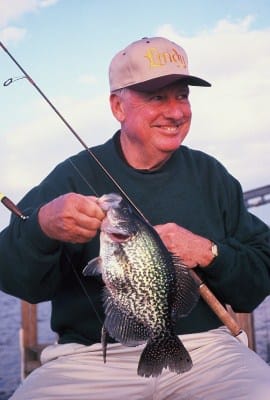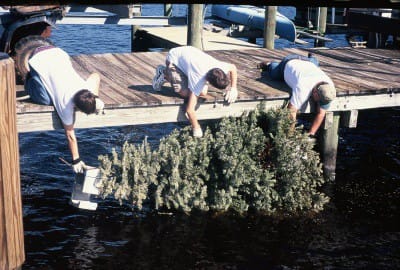By Bob McNally

Through the years my family has built our public waterway dock into an unparalleled fish haven by enhancing it with Christmas trees. Once each year we have a post-Christmas “dock day,” where we lug from 20 to 40 Christmas trees down and sink them using ropes and cinder blocks. We’ve been doing this annually for more than a decade, and it has turned my dock into one of the most sure-fire panfish magnets I ever flipped a jig under.
It’s important to check with local and state officials to learn the legality of sinking cover, especially in public, navigable water. In effect you’re creating freshwater reefs, but some laws are peculiar, and in some areas you may have to go to the trouble of requesting permits for sinking brush. It’s allowed on the reservoir where I live.
Christmas trees are ideal for building my sunken panfish castles because I can get a lot of them in a very short time. Fir, pine and spruce trees rot quickly once sunk, but I don’t care because there will be plenty more the following Christmas. Between Christmas and New Year’s Day, most people take down their trees and put them out front for garbage collection. Neighbors know I want trees and put them aside for me.
Be sure to wear gloves for this work, as Christmas trees are full of messy sap. I collect several dozen trees and deposit them near my dock for later sinking. I wait for a cool, clear, calm day, then get all the help I can from family and friends.
Sinking trees is quite simple, but there is some planning and time involved. You’ll need a sharp knife or two. Have plenty of sturdy, 1/4-inch diameter rope. I like real hemp, which eventually rots away, compared to nylon that will outlive me when discarded in water.
I’m fortunate to have neighbors who love giant Christmas trees, which is great, as one 14-footer is quicker and easier to sink than a pair of 6-footers. Sometimes, with giant trees, cutting them in half facilities the labor of handling, roping and sinking them.
While almost anything heavy can be used for tree and brush anchors, I prefer whole, large building cinder blocks. I’ve bought them from building supply stores, but I’ll use dozens during my annual Christmas tree sinking party. So I visit construction sites before the designated tree sinking day. Invariably there are damaged cinder blocks and usually a polite inquiry will lead you to all the broken, unusable blocks you’ll need.
While it’s proved conclusively that the higher profile a “reef” is made, the better it is for fish habitat, I sink Christmas trees so they are level on the bottom. I don’t want Christmas tree tops sticking above the surface, since it can be a boat hazard. More importantly, I don’t want to advertise I’ve sunk brush to every angler casting the waterway.
To sink trees horizontally, I securely rope a cinder block at each end of a tree, and two people slide it horizontally off the dock, where it settles quickly to the bottom. With huge trees, it often takes three whole cinder blocks to sink them fast, which is important because I don’t want trees drifting away from the dock. I want a tree in an exact spot so I can located it easily for fishing. Sometimes with a short tree, small brush clump, or tree top, I’ll use a single cinder block, tie it to the big base of the cover, then send it down. I work hard to sink trees tight to dock pilings, beside wooden cross supports and under pier planking. These are places sportfish ordinarily congregate.

In the frozen north, sinking Christmas trees and can be done very easily by dragging them onto winter ice. Make a pile of brush/trees, with lines and concrete blocks attached, then wait for the spring thaw to sink the cover. Be sure the spot you position brush on ice is where you want to sink trees when it thaws.
Every Christmas I think about how easy it was making brush piles with trees on the frozen lakes of Wisconsin, where I lived as a young man. But the extra effort of sinking trees in open water near my home is worthwhile because I can fish my dock cover 12 months of the year-confident that every time I cast a lure or bait a 2-pound crappie may be waiting.
The Union Sportsmen’s Alliance website is designed to provide valuable articles about hunting, fishing and conservation for members of AFL-CIO affiliated labor unions and all sportsmen and sportswomen who appreciate hunting and fishing and want to preserve our outdoor heritage for future generations. If you would like your own story and experience from the outdoors to be considered for our website, please email us atUSAmembers@unionsportsmen.org.



